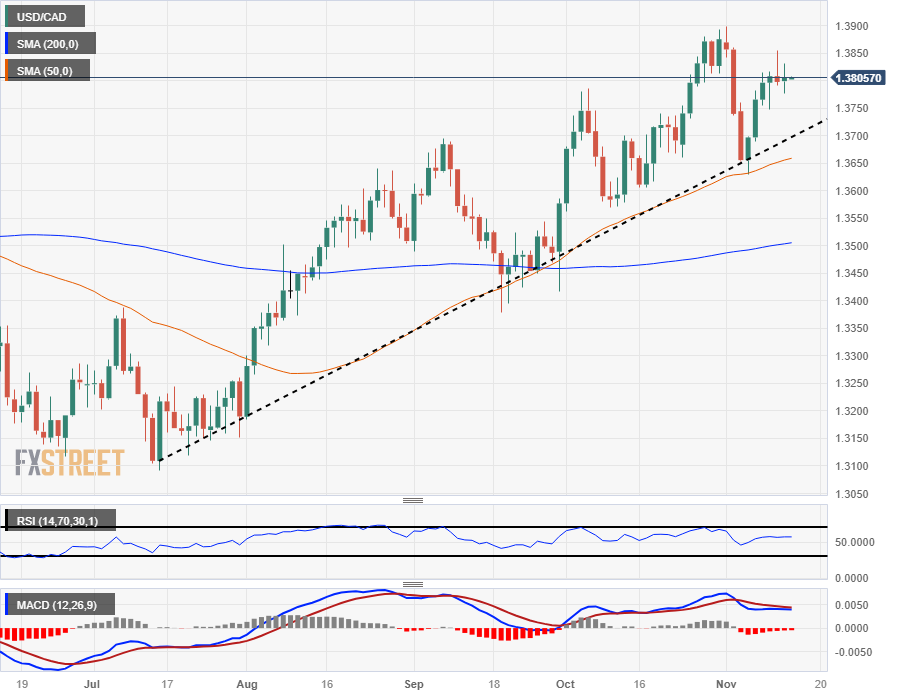- The Canadian Dollar is adrift on a thin market at the start of the trading week.
- Canada’s Remembrance Day holiday has most provinces out of the office for Monday.
- The economic calendar is sparse this week, little Canadian data on offer.
The Canadian Dollar (CAD) is finding little momentum in thin holiday markets, with the majority of Canadian provinces and territories taking the day off in observance of Remembrance Day.
There’s little of note on the economic data docket for the CAD this week, and the Loonie will be at the whim of overall market sentiment as the trading week unwinds.
Daily Digest Market Movers: Canadian Dollar shifting around a base of thin bids for Monday
- Monday momentum is limited, capping momentum in either direction to kick off the early trading week.
- There is a notable lack of viable economic data on offer for CAD traders this week.
- Loonie to trade according to market flows with a hefty US data schedule slated for this week.
- Early Tuesday will see Bank of Canada (BoC) Deputy Governor Toni Gravelle deliver talking points while participating in a panel discussion labeled "Challenges for Financial Stability and Financial Regulation amid Heightened Uncertainty".
- BoC Dep Gov Gravelle is participating in the Third High-Level Conference on Global Risk, Uncertainty, and Volatility, in Zurich, Switzerland.
- The BoC’s Council Member is not expected to move markets much, but investors will want to keep an eye out.
Technical Analysis: Canadian Dollar sees thin action for Monday, US Dollar in the driver’s seat
The CAD is seeing thin markets on Monday as it trades against the US Dollar (USD), and shifting sand beneath the Greenback is sending the USD/CAD pair down below the 1.3800 handle for Monday. Thin markets are set to keep the Loonie-Dollar pair constrained for the early part of the week’s trading session.
The USD/CAD is struggling to maintain bullish momentum following last week’s rebound from the 50-day Simple Moving Average (SMA) near 1.3630. A continuation of downside moves will see last Friday’s rejection from 1.3850 firm up into a technical ceiling below November’s early high bids near 1.3900.
On the downside, a bearish extension will see challenges from the 200-day SMA currently pushing upward through 1.3500. A lack of recent directional momentum is seeing technical indicators begin to drift toward the middle, with the Relative Strength Index (RSI) currently heading into the 50.0 median barrier.
USD/CAD Hourly Chart

USD/CAD Daily Chart

Canadian Dollar price this week
The table below shows the percentage change of Canadian Dollar (CAD) against listed major currencies this week. Canadian Dollar was the strongest against the New Zealand Dollar.
| USD | EUR | GBP | CAD | AUD | JPY | NZD | CHF | |
| USD | -0.09% | -0.42% | 0.04% | -0.23% | 0.14% | 0.23% | -0.05% | |
| EUR | 0.09% | -0.33% | 0.14% | -0.13% | 0.22% | 0.32% | 0.03% | |
| GBP | 0.41% | 0.33% | 0.46% | 0.19% | 0.55% | 0.66% | 0.36% | |
| CAD | -0.05% | -0.13% | -0.46% | -0.28% | 0.09% | 0.19% | -0.10% | |
| AUD | 0.23% | 0.13% | -0.18% | 0.26% | 0.35% | 0.47% | 0.18% | |
| JPY | -0.14% | -0.23% | -0.55% | -0.10% | -0.37% | 0.11% | -0.19% | |
| NZD | -0.23% | -0.33% | -0.66% | -0.20% | -0.47% | -0.11% | -0.30% | |
| CHF | 0.05% | -0.03% | -0.36% | 0.10% | -0.16% | 0.19% | 0.29% |
The heat map shows percentage changes of major currencies against each other. The base currency is picked from the left column, while the quote currency is picked from the top row. For example, if you pick the Euro from the left column and move along the horizontal line to the Japanese Yen, the percentage change displayed in the box will represent EUR (base)/JPY (quote).
Central banks FAQs
What does a central bank do?
Central Banks have a key mandate which is making sure that there is price stability in a country or region. Economies are constantly facing inflation or deflation when prices for certain goods and services are fluctuating. Constant rising prices for the same goods means inflation, constant lowered prices for the same goods means deflation. It is the task of the central bank to keep the demand in line by tweaking its policy rate. For the biggest central banks like the US Federal Reserve (Fed), the European Central Bank (ECB) or the Bank of England (BoE), the mandate is to keep inflation close to 2%.
What does a central bank do when inflation undershoots or overshoots its projected target?
A central bank has one important tool at its disposal to get inflation higher or lower, and that is by tweaking its benchmark policy rate, commonly known as interest rate. On pre-communicated moments, the central bank will issue a statement with its policy rate and provide additional reasoning on why it is either remaining or changing (cutting or hiking) it. Local banks will adjust their savings and lending rates accordingly, which in turn will make it either harder or easier for people to earn on their savings or for companies to take out loans and make investments in their businesses. When the central bank hikes interest rates substantially, this is called monetary tightening. When it is cutting its benchmark rate, it is called monetary easing.
Who decides on monetary policy and interest rates?
A central bank is often politically independent. Members of the central bank policy board are passing through a series of panels and hearings before being appointed to a policy board seat. Each member in that board often has a certain conviction on how the central bank should control inflation and the subsequent monetary policy. Members that want a very loose monetary policy, with low rates and cheap lending, to boost the economy substantially while being content to see inflation slightly above 2%, are called ‘doves’. Members that rather want to see higher rates to reward savings and want to keep a lit on inflation at all time are called ‘hawks’ and will not rest until inflation is at or just below 2%.
Is there a president or head of a central bank?
Normally, there is a chairman or president who leads each meeting, needs to create a consensus between the hawks or doves and has his or her final say when it would come down to a vote split to avoid a 50-50 tie on whether the current policy should be adjusted. The chairman will deliver speeches which often can be followed live, where the current monetary stance and outlook is being communicated. A central bank will try to push forward its monetary policy without triggering violent swings in rates, equities, or its currency. All members of the central bank will channel their stance toward the markets in advance of a policy meeting event. A few days before a policy meeting takes place until the new policy has been communicated, members are forbidden to talk publicly. This is called the blackout period.
Information on these pages contains forward-looking statements that involve risks and uncertainties. Markets and instruments profiled on this page are for informational purposes only and should not in any way come across as a recommendation to buy or sell in these assets. You should do your own thorough research before making any investment decisions. FXStreet does not in any way guarantee that this information is free from mistakes, errors, or material misstatements. It also does not guarantee that this information is of a timely nature. Investing in Open Markets involves a great deal of risk, including the loss of all or a portion of your investment, as well as emotional distress. All risks, losses and costs associated with investing, including total loss of principal, are your responsibility. The views and opinions expressed in this article are those of the authors and do not necessarily reflect the official policy or position of FXStreet nor its advertisers. The author will not be held responsible for information that is found at the end of links posted on this page.
If not otherwise explicitly mentioned in the body of the article, at the time of writing, the author has no position in any stock mentioned in this article and no business relationship with any company mentioned. The author has not received compensation for writing this article, other than from FXStreet.
FXStreet and the author do not provide personalized recommendations. The author makes no representations as to the accuracy, completeness, or suitability of this information. FXStreet and the author will not be liable for any errors, omissions or any losses, injuries or damages arising from this information and its display or use. Errors and omissions excepted.
The author and FXStreet are not registered investment advisors and nothing in this article is intended to be investment advice.
Recommended content
Editors’ Picks

Gold trades in a rangebound mood around $3,300
Gold now seems to have embarked on a daily consolidation around the $3,300 mark per troy ounce following an all-time peak near $3,320 during early trade. Continued concerns over the escalating US-China trade tensions and a weakening Greenback, support the demand for the metal prior to Powell's speech.

EUR/USD remains consolidative around 1.1350 on firmer US Retail Sales
EUR/USD maintains its daily gains around the 1.1350 region on the back of the resumption of the bearish tone in the Greenback, which showed no reaction to the stronger-than-expected Retail Sales in March. Later in the day, investors are expected to closely follow Fed Chairman Powell’s comments on the economic outlook.

GBP/USD recedes from tops and revisits the 1.3250 zone
GBP/USD extends its positive streak on Wednesday, now coming under some selling pressure around the 1.3250 after earlier multi-month tops around the 1.3300 mark. The daily uptick comes on the back of the weaker US Dollar and easing inflationary pressure in the UK.

BoC set to leave interest rate unchanged amid rising inflation and US trade war
All the attention is expected to be on the Bank of Canada this Wednesday as market experts widely anticipate the central bank to maintain its interest rate at 2.75%, halting seven consecutive interest rate cuts.

Future-proofing portfolios: A playbook for tariff and recession risks
It does seem like we will be talking tariffs for a while. And if tariffs stay — in some shape or form — even after negotiations, we’ll likely be talking about recession too. Higher input costs, persistent inflation, and tighter monetary policy are already weighing on global growth.

The Best brokers to trade EUR/USD
SPONSORED Discover the top brokers for trading EUR/USD in 2025. Our list features brokers with competitive spreads, fast execution, and powerful platforms. Whether you're a beginner or an expert, find the right partner to navigate the dynamic Forex market.



